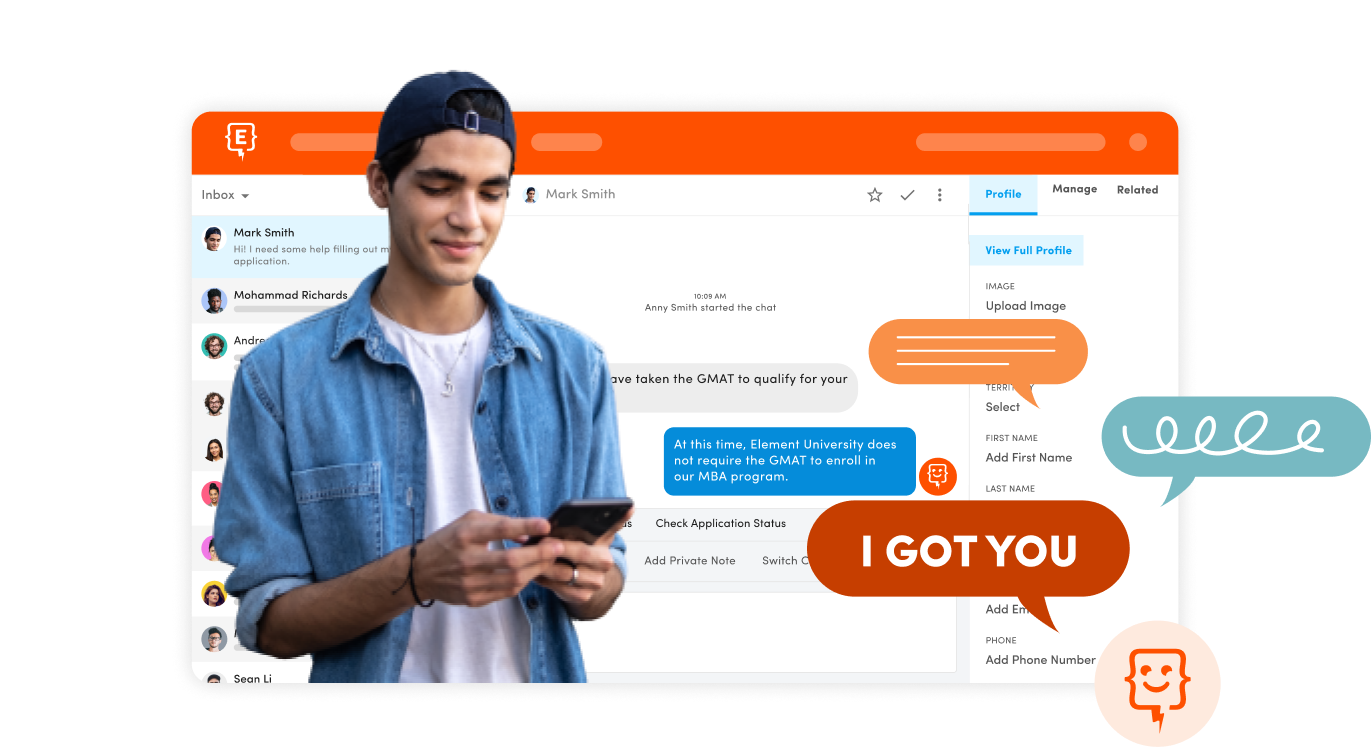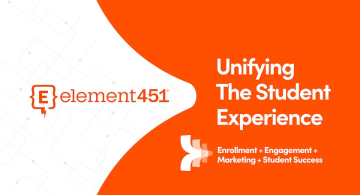Slate Alternatives & Higher Ed CRM Competitors
by Rita Winthrop · Updated Sep 13, 2024
Digital technologies have become crucial for student admissions, recruitment, and enrollment in higher education. Modern workflow upgrades can make life easier for staff members who are extremely busy trying to engage and build relationships with future students.
Keeping up with demand and digital productivity is a tall order—even for schools that have high budgets and expansive resources. Fortunately, Customer Relationship Management (CRM) platforms simplify the process of managing student enrollment at scale, throughout the industry.
Campus staff must keep up with modern trends and boost recruitment efforts by selecting the most suitable solution.
Throughout this CRM series, we’ll guide you through the world of higher education CRM platforms while showcasing how Element451 stacks up to other popular options.
Market Trends in Higher Ed CRM Platforms
With new upgrades and improvements, many CRM platforms are continually evolving. Features expand, and users get access to more powerful management software and data tool sets. In the midst of these changes, here are some of the most prominent trends in the realm of higher ed CRM technology.
Personalization and Student Engagement: Platforms focus heavily on personalized communications, placing the student at the center of discussions and activities.
Artificial Intelligence and Machine Learning: AI content creation tools are gaining steam in the higher ed admissions world. Plus, new algorithms quickly anticipate student expectations, leading to better interactions as enrollment choices happen in real time.
Mobile Accessibility: A mobile-first mindset among students has led to platforms that are more convenient, intuitive, and flexible. This adaptability ensures that staff have access to relevant engagement information located on-platform on various devices.
Alumni Engagement: Modern solutions should be able to expand information beyond the current student lifecycle. This opens the door to better alumni relations, revenue, fundraising attempts, and lifelong engagement. With alumni relationship management features, colleges and universities are focusing long-term relationships with former students.
Streamline Multichannel Communication: A qualified, multichannel approach to engagement comes easily with today’s higher ed platforms. This includes support for communication across a diverse library of channels, including social media. The primary focus is on reaching prospective attendees where they spend a majority of time.
How to Perform Competitor Analysis
If you’re a decision-maker for your school’s enrollment management team, there are several best practices to remember when choosing a tool. First, it’s vital to assess whether the solution’s features and functionality align with the current state of your recruiting needs.
As you survey Slate competitors, prioritize and search for the following components.
- Communication—Does the platform easily manage communication with prospective students? Are there any data silos that prevent or hinder effective sharing between important parties?
- Customization—The ability to finetune your chosen CRM platform as a way to target specific needs matters. How much control do you have over settings, implementation, and student-facing interactions?
- Data Tracking—An effective system should allow for detailed tracking and analysis. The ability to link and integrate student data with other higher ed tools can make the difference between frustration and smooth sailing.
Slate CRM Overview
Slate, a CRM platform by Technolutions, is highly adaptable. Institutions can meet several specific needs as they relate to student success, advancement, and admissions processes. In the sections that follow, we’ll provide an overview of the Slate platform.
Strengths of Slate
Slate is designed specifically with education leaders and professionals in mind. This means that it’s highly adapted to particular needs across campuses. Slate is recognized for features such as:
- Centralization—University data throughout the student lifecycle is consolidated, with transactional data easily accessible and visible to relevant team members.
- Robust Student Recruitment tools—Slate provides several features to guide student recruitment. The toolset includes customizable forms, embedded videos, and social media integrations, multilingual documents, and event management.
- Admissions toolkit—Slate's admission dashboard builds a holistic, birds-eye view of the entire admission process. A dashboard shows where students are in the funnel, making it easier to track interactions and provide a seamless experience.
Weaknesses of Slate
As with any platform, Slate also comes with a few downsides based on user interactions and experiences. Some of the potential drawbacks might include:
- A steeper learning curve with the complexity required to master the software fully, with many users reporting an immense training need before starting
- Lack of customer support (including phone support) that could make it challenging to receive or find tailored answers
- A pricing structure that may be out-of-budget for some smaller institutions
Pricing Comparison
Slate’s pricing starts with licenses that cost $30,000 per year, with customized pricing for larger institutions. Slate’s website states that most customers pay a starting price of $50,000 annually, although price hikes are rare.
What Customers Say
Slate’s overall customer satisfaction rating is 4.4/5 on G2. While complaints are minor, most users benefit from the simplified recruitment experience and data analytics options.
Compare to Salesforce Education Cloud—Slate Competitor
Salesforce Education Cloud addresses the challenges of higher ed enrollment with a power that’s backed by Salesforce—a global leader in CRM technology.
The Education Cloud, a branch of Salesforce’s overarching CRM technology, focuses on student engagement, recruiting, and even alumni engagement. The Education Cloud benefits from the Student Success Hub, which provides a complete view of an individual’s academic journey.
Strengths of Salesforce Education Cloud
Advantages of using Salesforce for education include:
- Features that help admins build a robust understanding of all factors that potentially impact student success
- A high-powered Student Success Hub that helps teams monitor and respond to student progress with personalization
- Intuitive tracking and communication tools that simplify engagement management, helping more students gain access to success resources
Weaknesses of Salesforce Education Cloud
Despite its impressive background, Salesforce Education Cloud does come with a few downsides. Possible drawbacks might include:
- A steep learning curve (particularly within the Salesforce ecosystem) and a longer time to launch and begin working on the platform
- A software complexity that necessitates increased web, IT, or tech support
- Additional maintenance on the part of the institution
- The need to rely on Salesforce training packages or consulting partners that come at additional cost
Pricing Comparison
Unfortunately, Salesforce Education Cloud does not publicize its pricing or offer clear tiers for licensing. Interested customers must get in touch with an Account Executive to discuss options. Because Salesforce Education Cloud has such a wide range of features and capabilities, pricing may come in higher or lower than what an organization hopes to spend.
What Customers Say
Because Salesforce Education Cloud is a worldwide choice for institutions, there’s no shortage of impressive customer reviews and knowledge about the platform. Overall, users report that the Education Cloud assists their schools with better lead generation, increased rates of student engagement, and decreased time in manual effort and data management tasks.

See How BoltBot Works
Future-proof student success with the intelligent chatbot for higher ed. Harness BoltBot's ever-growing knowledge base and 24/7 access to create a frictionless student experience.
Get a Demo
Compare to TargetX—Slate Competitor
TargetX is another well-known and reliable CRM platform for colleges and universities. The cloud based TargetX platform prioritizes customization and automation.
Additionally, with a vast partnership and integration library, TargetX is a great option for any institution that requires advanced customization, secure third-party integrations, or tools that enable growth at scale. Over the years, TargetX has continually paved the path as a leader in innovative CRM technology designed specifically for higher ed.
Strengths of TargetX
TargetX excels with streamlined academic operations, which encompasses the steps from admissions to enrollment and beyond. Major advantages of TargetX include:
- Ability to quickly automate time-consuming administrative tasks across the whole organisation, such as data management, email marketing, or monitoring
- Cloud-based CRM platform tools for easily accessible data from anywhere
- Seamless, secure integration to multiple third-party platforms, improving the strength and usability of student data
Weaknesses of TargetX
Some TargetX limitations stem from its lackluster data reporting or analytical capabilities. Vast customization settings also create additional work when creating and building new reports, which can contribute to confusion for end users. TargetX also comes with a higher price tag than some of its competitors, which makes it more unaffordable for small schools.
Pricing Comparison
TargetX uses a pricing model based on the size of the institution, in addition to how many specific platform features that institution requires. Unfortunately, TargetX doesn’t publicly disclose pricing which means that interested schools need to connect with an Account Executive. The platform does provide a free demo and custom quotes upon request.
What Customers Say
TargetX has focused on reliable, out-of-the-box education solutions for many years. Organizations point out that TargetX enables a greater level of personalized communication and automation, making it a trustworthy choice for schools that need to enhance the student lifecycle management process. The platform currently has a 3.9/5 rating on G2.
Element451 as Your Best Slate Competitor
Element451 is a go-to choice for institutions across the country that want to accelerate the student engagement process. With years of advancement and improvements, Element451 offers the following benefits to forward-thinking leaders aiming to prioritize student relationships and interactions.
Additional Customization Options for High Engagement
Element451 offers a highly supportive customizable experience for customers, users, and admins. With Element451, staff members can create automated workflows, set up highly personalized communication pathways across multiple channels, develop modern marketing content, and generate rich insights and reporting regarding the student experience.
Community colleges, small private institutions, online graduate schools, and large state universities can all benefit from this unique offering.
Updated and Modern Design
Because one of the biggest Slate downsides is its outdated design and disjointed UX, it’s refreshing to find an intuitive platform that’s visually appealing and user-friendly. Admissions team members should be able to navigate the software easily and build what they need without hassle. Element451’s clean design is intuitive, easy to use, and truly prioritizes the student-first experience.
Advanced AI Functionality
Tools and features like BoltBot and Bolt Copilot are blazing a path forward for CRM advancement. AI-created content across multiple channels allows recruiting and admissions teams to scale and achieve impressive results, all while connecting back to a single source of truth and student data. Better control helps teams manage the content they create with as little as a single click.
Cost-Effective, Flexible Starting Price Models
Element451's pricing is highly affordable and driven by customer results. With yearly licenses that start at $20,000, customers can easily select the plan level that best aligns with available budget and specific feature needs. No long-term contracts or implementation fees mean that it’s easy to switch from another platform or provider.
Choose the Best Slate Alternatives for Your Institution
As you make the move toward a higher ed platform, consider the needs and expectations of your institution before selecting your Slate alternative. Although pricing, feature sets, and user interface make a difference, the power of customer testimonials is also highly relevant.
What results are schools experiencing? How is life easier or better for admissions officers and recruiting staff? Peel back the layers to find out how each software feature generates practical change in the lives of the platform’s users and target audience.
Let’s Chat about CRM Performance
If you’re actively assessing your institution's unique recruitment, enrollment, and admissions needs, the right CRM solution is bound to put you on the fast track. Find the right Slate competitor now, and to take your future recruiting efforts to new heights.

About Element451
Boost enrollment, improve engagement, and support students with an AI workforce built for higher ed. Element451 makes personalization scalable and success repeatable.
Categories
New Blog Posts

The Definitive Guide
AI in Higher Education
Bridge the gap between the latest tech advancements and your institution's success.
Related Articles

Talk With Us
Element451 is the only AI Workforce Platform for higher education. Our friendly experts are here to help you explore how Element451 can improve outcomes for your school.
Get a Demo








